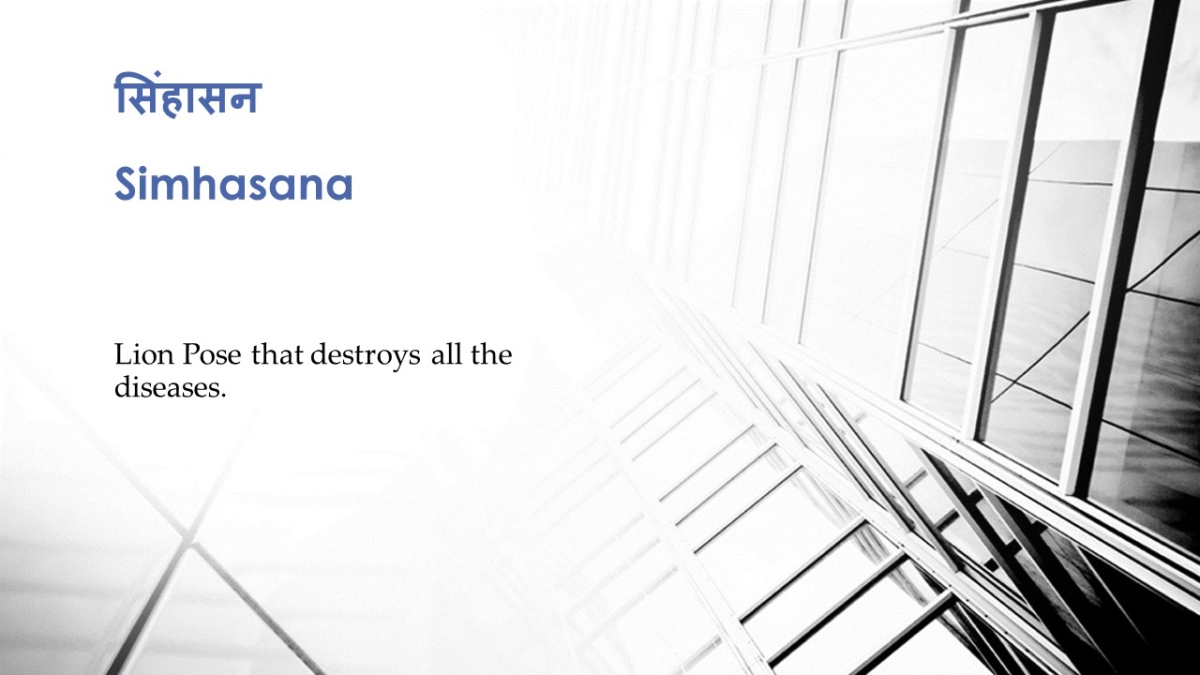Introduction
Simhasana is a seated yoga position. Almost all medieval yoga texts mention this posture. Moreover, the 10th Century CE Text Vimānārcanākalpa mentions this yoga posture.
Thirumoolar in his text Thirumandiram describes Simhasana. The period of Thirumoolar must be anytime before Sixth Century CE. Not later than that. This is because Thirujnanasambandar, who was a contemporary of King Varaguna Pandiyan of the Seventh Century mentioned Thirumoolar.
Hence it is evident that this posture has been in practice for more than 1500 years.
Simhasana Information
| Pose Name | Simhasana |
| Sanskrit Name | सिंहासन |
| IAST Name | Siṁhāsana |
| English Name | Lion Pose |
| Difficulty Level | Moderate |
| Origin | Classic Yoga Period Before Medieval Yoga Period |
| Type | Seated Posture |
Simhasana Meaning
Simha means a Lion. Asana means a seat or pose. So Simhasana means Lion Pose. On performance, this posture resembles a Lion. Hence it has got this name.
How to Do Simhasana?
Safety and Precautions
This posture requires the folding of knees. Though it is easy to perform, some people may find it hard to fold the knees as required. They should forcefully fold their knees which may result in injury. They should take care and perform this posture under competent supervision.
Those who already had injury or who had a surgery on their knees should avoid this posture.
Preparatory Poses
One should prepare himself with the following postures before attempting Lion Pose.
Simhasana Steps
Step 1
Sit in Vajrasana with big toes touching together. Keep the knees apart.
Step 2
Lean forward and place the palms on the floor in between the knees, elbows, and fingers facing the body. Keep the arms straight and place the upper body weight on the arms. Adjust your forward-leaning accordingly. Keep your head straight and a little upward.
Step 3
Fix your eyesight on any object in front. Breathe slowly.
Step 4
At the end of inhalation, open your mouth fully, stretch your tongue out and down towards the chin, and exhale by generating a sound “aaaaahhh” from the deep part of the throat. After exhalation, close your mouth, slowly inhale.
Variation
The yoga texts did not mention Step 4 in the description of Lion Pose. Step 4 is a part of another variation of this posture called Simha Garjanasana or Lion’s Roar Pose. Lion pose without step 4 is used for meditation.
Follow Up Poses
Subsequently after the performance of Lion Pose, one should follow up with any of the below mentioned postures.
Advanced Pose Considerations
Instead of starting with Vajrasana in Step 1, one may start with Padmasana. In this case, there is a modification in Step 2. One should lean forward and place the knees on the floor. Now the body is supported by the palms and knees only. Continue the pose with the other steps.
Simhasana Benefits
- The lion Pose without step 4 is a very good pose for meditation. It calms the mind and puts oneself into a deep meditative state. Moreover, the whole body is completely relaxed.
- It is a suitable posture for the performance of Shambhavi Mudra and Khechari Mudra
- Lion’s Roar Pose removes the diseases of the throat.
- It activates the Visuddhi and Ajna Chakras.
- Lion’s Roar Pose is good for conditions like stuttering. Apart from this, one gets a beautiful voice.
Simhasana in Yoga Texts
Lion Pose in Thirumandiram
The earliest description of Lion Pose is found in Thirumandiram of Thirumoolar.
Kneel down. Stretch out the arms on them. While opening the mouth, fix the eyesight on the tip of the nose. This is Lion Pose.
– Thirumandiram Verse 562
Lion Pose in Hatha Yoga Pradipika
This text describes Lion Pose in three verses.
Place right ankle on the left side of the scrotum and the left on the right side of the perineum.
Then place the palms on the knees with fingers stretched out. Keep the mouth open and gaze in front of the nose with a controlled mind.
This one is Simhasana, adored by the greatest caliber. This admirable Asana is suitable for three Bandhas. (Mulabandha, Uddiyana Bandha, and Jalandhra Bandha.
– Hatha Yoga Pradipika 1.50, 1.51, and 1.52.
Lion Pose in Gheranda Samhita
This yoga text describes the Lion Pose in two verses.
Place both the heels under the scrotum on the opposite sides, facing up. Placing knees on the floor, open the mouth, fix your eyesight on the tip of the nose, and perform Jalandhara Bandha. This is Simhasana that destroys all the diseases.
– Gheranda Samhita 1.14 and 1.15
Lion Pose in Hatha Ratnavali
According to this yoga text, ten poses are more important than other poses. The ten poses are Svastikasana, Gomukhasana, Padmasana, Virasana, Siddhasana, Mayurasana, Kukkutasana, Bhadrasana, Simhasana, and Muktasana.
Out of these, four yoga poses are more essential. The four Asanas are Siddha, Padma, Simha, and Bhadra.
This text also describes Lion Pose which is similar to the description given by Hatha Yoga Pradipika.
Lion Pose in Hatha Tattva Kaumudi
Verse 7.14 and 7.15 give a similar description of Lion Pose as given in Hatha Yoga Pradipika. Moreover, the next verse explains the benefits.
Nadis regain their functions. All limbs like arms and legs become light. Under the scrotum means the side of the perineum.
This is Yogasimhasana that eliminates the diseases of Vada or wind.
– Hatha Tattva Kaumudi 7.16
